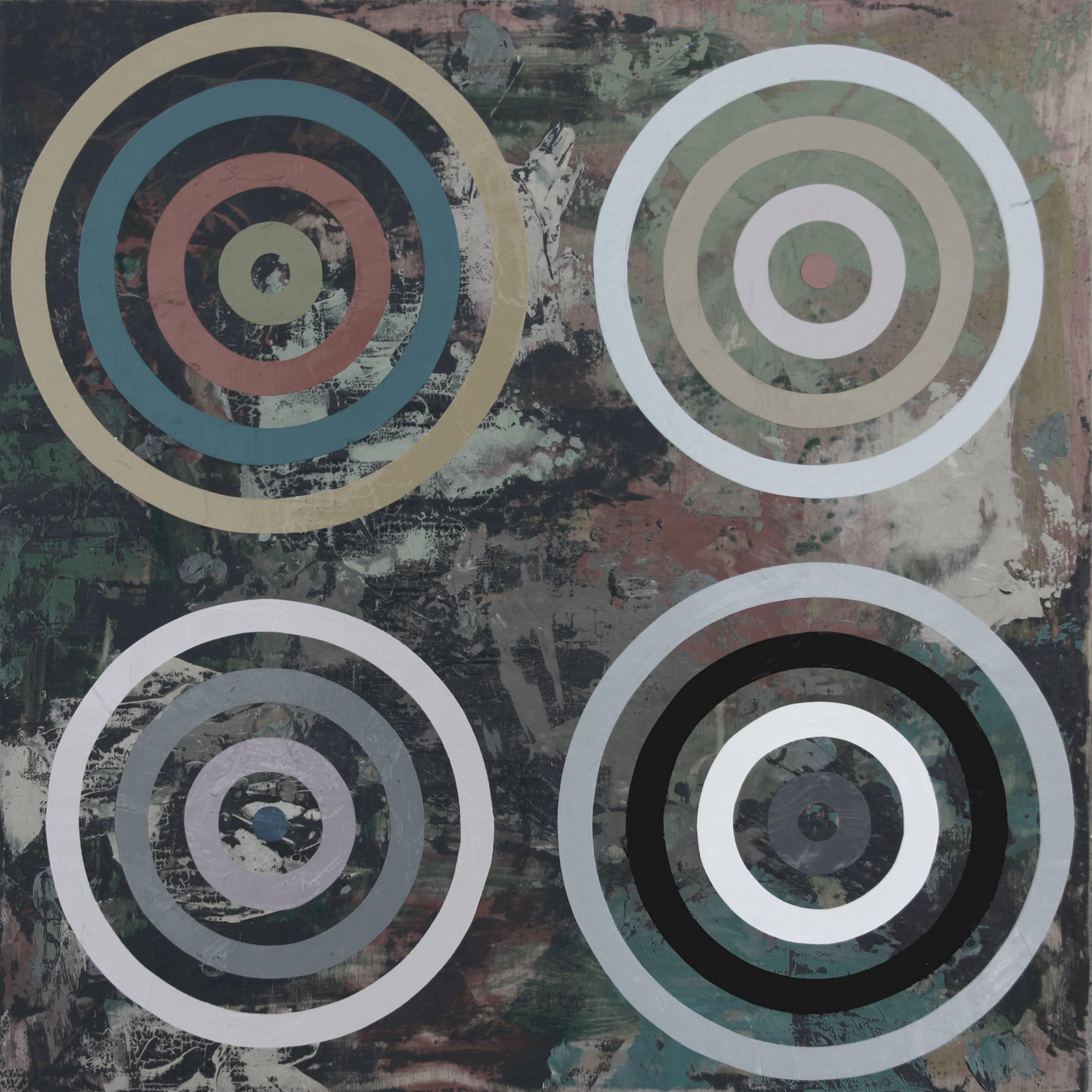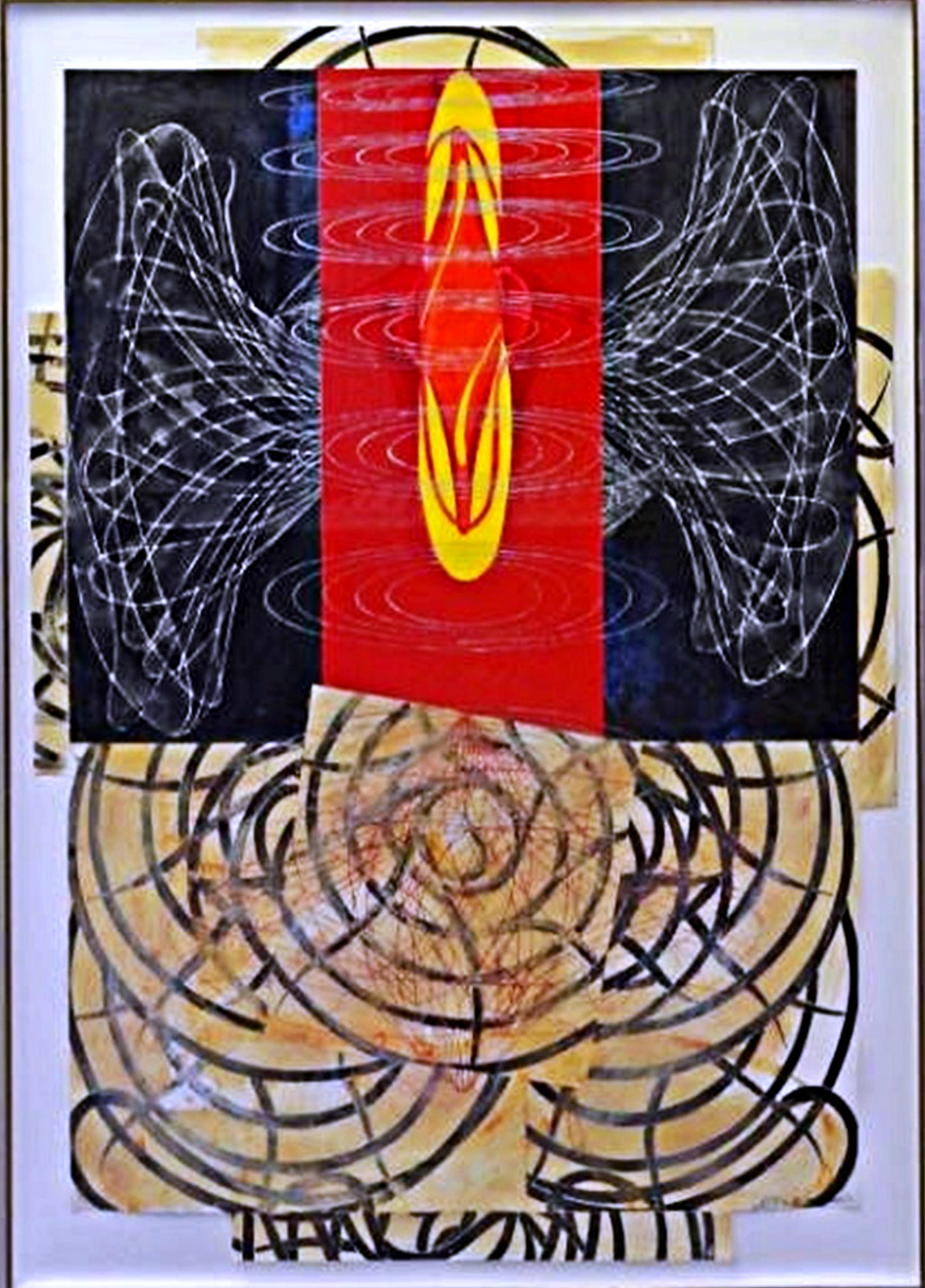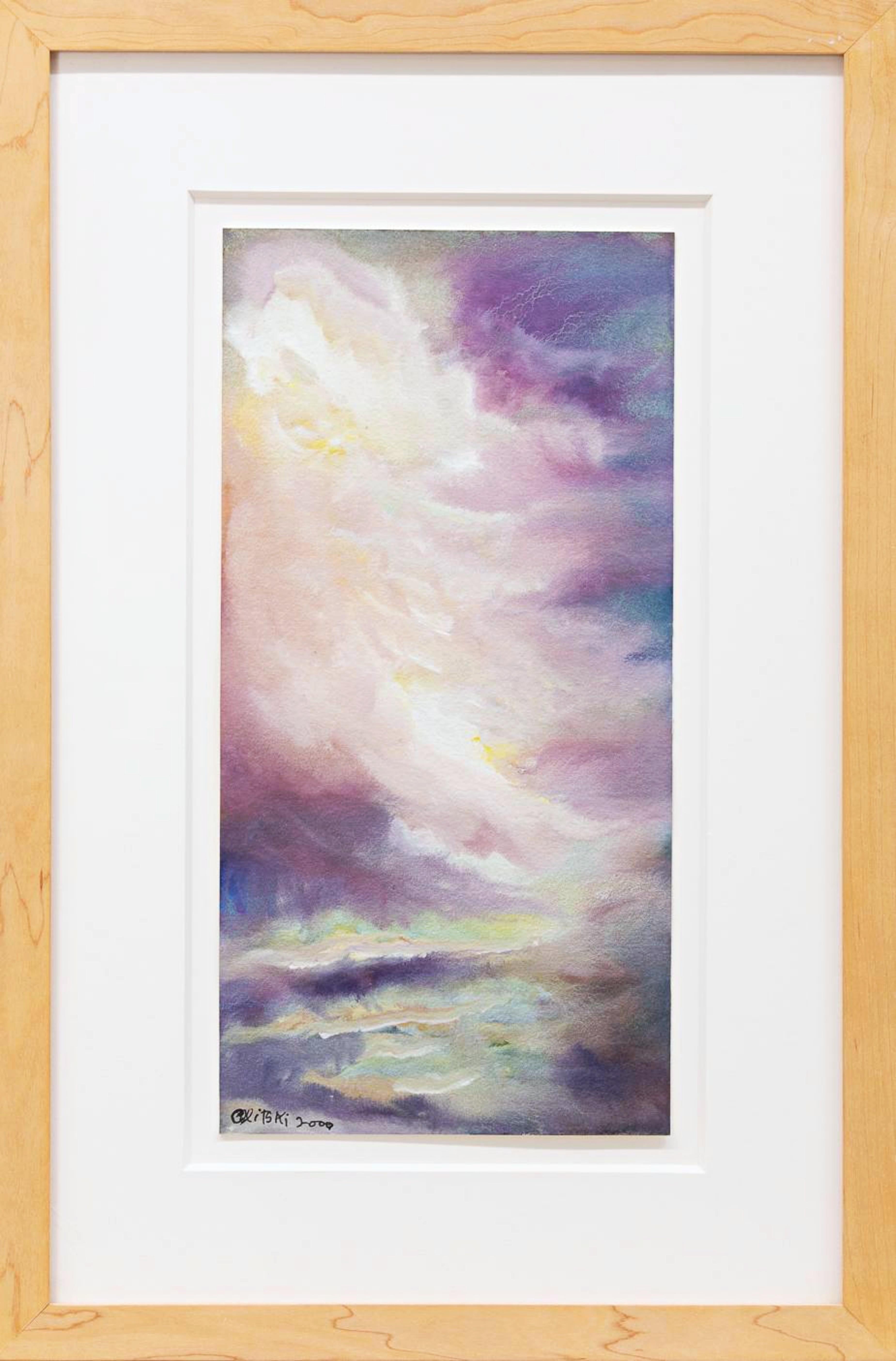Items Similar to Dexter's Choice, State II
Want more images or videos?
Request additional images or videos from the seller
1 of 8
Larry ZoxDexter's Choice, State II1990
1990
About the Item
Larry Zox
Dexter's Choice, State II, ca. 1990
Mixed media, Watercolor pochoir, and Oil stick Wax, Water-Based Crayons, on heavy Arches museum watercolor rag paper with deckled edges
40 × 60 in
101.6 × 152.4 cm
Edition 8/30 (unique variant)
Frame included
Measurements:
Sheet: 40 inches (vertical) by 60 inches (horizontal)
Frame: 42 inches x 62 inches x 1 inch
Dexter's Choice, State # II is a unique, mixed media work from an edition of 30 unique variants done in pochoir, (25 stencils, 14 colors). Here, Zox uses watercolor instead of inks, which is applied to heavy 300 lb. watercolor paper. Although it is a multiple signed and numbered from the edition of 30, each work of art is unique because of how the paper receives the watercolor brush. In addition, this work is created like a mixed media painting because it has 11 lines added by hand with wax and water based crayons and oil sticks. The unique watercolor technique that Zox employed in making "Dexter's Choice" is documented in the textbook, "Screen Printing: Water Based Techniques,Roni Henning, NYIT ".
Dexter's Choice was published by Images Gallery, and this work was acquired directly from the publisher before they sold out. This work is elegantly floated and framed in a white wood frame.
Larry Zox Biography:
A PAINTER who played an essential role in the Color Field discourse of the 1960s and 1970s, Larry Zox is best known for his intensely and brilliantly colored geometric abstractions that question and violate symmetry.1 Zox stated in 1965: “Being contrary is the only way I can get at anything.” To Zox, this position was not necessarily arbitrary, but instead meant “responding to something in an examination of it [such as] using
a mechanical format with X number of possibilities.”2 What he sought was to “get at the specific character and quality of each painting in and for itself,” as James Monte stated in his introductory essay in the catalogue for Zox’s 1973–1974 solo exhibition at the Whitney Museum of American Art.3 Zox’s robust paintings reveal
a celebrated artist and master of composition who is explored and challenged the possibilities of Post-Painterly Abstraction and Minimalist pictorial conventions.
Zox began to receive attention in the 1960s when he was included in several groundbreaking exhibitions of Color Field and Minimalist art, including Shape and Structure (1965), organized by Henry Geldzahler and Frank Stella for Tibor de Nagy, New York, and Systemic Painting (1966), organized by Lawrence Alloway for the Solomon R. Guggenheim Museum, New York. In 1973–1974, the Whitney’s solo exhibition of Zox’s work gave recognition to his significance in the art scene of the preceding decade. In the following year, he was represented in the inaugural exhibition of the Hirshhorn Museum and Sculpture Garden, Wahsington, DC, which acquired fourteen of his works.
Zox was born in Des Moines, Iowa in 1937. He attended the University of Oklahoma and Drake University, Des Moines, Iowa, and then studied under George Grosz at the Des Moines Art Center. In 1958, Zox moved to New York, joining the downtown art scene. His studio on 20th Street became a gathering place for artists, jazz musicians, bikers, and boxers, and he occasionally sparred with visiting fighters. He later established a studio in East Hampton, a former black smithy used previously by Jackson Pollock.
In his earliest works, such as Banner (1962) Zox created
collages consisting of pieces of painted paper stapled onto sheets of plywood. He then produced paintings that were illusions of collages, including both torn- and trued-edged forms, to which he added a wide range of strong hues that created ambiguous surfaces. In paintings such as For Jean (1963), he omitted the collage aspect of his work and applied flat color areas to create more complete statements of pure color and shape. He then replaced these torn and expressive edges with clean and impersonal lines that would define his work for the next decade.
From 1962 to 1965, he produced his Rotation series, at first creating plywood and Plexiglas reliefs, which turned squares into dynamic polygons. He used these shapes in his paintings as well, employing white as a foil between colors to produce negative spaces that suggest that the colored shapes had only been cut out and laid down instead of painted. The New York Times in 1964 wrote of the works in show such as Rotation B (1964) and of the artist: “The artist is hip, cool, adventurous, not content to stay with the mere exercise of sensibility that one sees in smaller works.”4
In 1965, he began the Scissor Jack series, in which he arranged opposing triangular shapes with inverted Vs of bare canvas at their centers that threaten to split their compositions apart. In several works from this series, Zox was inspired by ancient Chinese water vessels. With a mathematical precision and a poetic license, Zox flattened the three dimensional object onto graph paper, and later translated his interpretation of the vessel’s lines onto canvas with masking tape, forming the structure of the painting.
The Diamond Cut and Diamond Drill paintings followed. In these, he used regularized formats as a means of revealing how color can change our perception of shape. In a single work he often combined industrial epoxy paints with acrylic to set up tensions between colors that would not exist otherwise. Writing about works like
Cordova (1967) and Esso Lexington (1968), Peter Schjeldahl observed in the New York Times: “[Zox] is one painter who
shows an ability to play by the rules without cramping at all an essentially romantic and exuberant sensibility.”5 In an essay for
an exhibition at Dartmouth College Schjeldahl elaborated: “Zox has clearly adapted Post-Painterly procedures and Minimal pictorial conventions to the demands of a free-wheeling, lyrical sensibility.”6 His art of the period is equated with that of Frank Stella and Kenneth Noland.
In the late 1960s, Zox’s paintings, such as in his Gemini series (1969–1972), became brushier; he often incorporated powdered mica into his paints to increase their visual effect. He explored a variety of new means of applying paint early in the following decade, including using squeegees and other large tools. With these means, he moved away from preconception, while introducing a drawing procedure in which the outside limits of a painting were determined by cutting or cropping the canvas.
In the mid-1970s, Zox created a series of paintings in which he explored lateral tensions, leaving the centers of his works blank. He continued to stretch Color Field limits in the 1980s, combining the detachment of paint staining with gestural brushwork balanced between intuition and intentionality. He created more fluid yet still rigorous paintings in the early 2000s that were receiving critical praise when he died in 2006 from cancer.
Zox taught at the School of Visual Arts, New York, in 1967, 1968, 1977, and 1980. He was artist in residence or guest artist at many universities such as Yale, Syracuse, Cornell, and Dartmouth. His honors include a Guggenheim Fellowship (1967) and awards from the National Council of the Arts (1969) and the Adolph Gottlieb Foundation (1985). Throughout his career, Zox had annual solo shows in galleries in New York City and around the world. In addition to the Whitney exhibition of 1973 and 1974, he had solo shows at the Hopkins Center, Dartmouth College, Hanover, New Hampshire (1970), the Akron Art Institute, Ohio (1971), the Des Moines Art Center, Iowa (1974), and the Marsh Gallery, University of Richmond, Virginia (1993). He participated in many notable museum and college gallery exhibitions at venues including the Whitney Museum of American Art, New York; Vassar College, Poughkeepsie, New York; the Palm Springs Art Museum; the Solomon R. Guggenheim Museum, New York; the Charles H. MacNider Museum, Mason City, Iowa; the Des Moines Art Center; the Blanden Memorial Art Museum, Fort Dodge, Iowa; and the Muscatine Art Center, Iowa.
Zox is represented in over one hundred museum collections.
In addition to the Hirshhorn, his work is included in the Museum
of Modern Art, New York; the Whitney Museum of American Art, New York; the Metropolitan Museum of Art New York; the Solomon R. Guggenheim Museum, New York; the Tate Modern, London;
the Weserburg Museum, Bremen, Germany; the Museum of Fine Arts, Boston; the Fogg Art Museum, Harvard University, Cambridge, Massachusetts; The Museum of Fine Arts, Houston; and the Dallas Museum of Art.
-Courtesy of Berry Campbell Gallery
- Creator:Larry Zox (1936-2006, American)
- Creation Year:1990
- Dimensions:Height: 42 in (106.68 cm)Width: 62 in (157.48 cm)Depth: 1.5 in (3.81 cm)
- Medium:
- Movement & Style:
- Period:
- Condition:
- Gallery Location:New York, NY
- Reference Number:1stDibs: LU174529817532
About the Seller
5.0
Platinum Seller
These expertly vetted sellers are 1stDibs' most experienced sellers and are rated highest by our customers.
Established in 2007
1stDibs seller since 2022
286 sales on 1stDibs
Typical response time: 1 hour
- ShippingRetrieving quote...Ships From: New York, NY
- Return PolicyA return for this item may be initiated within 1 day of delivery.
More From This SellerView All
- In Real Time, unique signed mixed media Abstract Expressionist painting, FramedBy Steven SormanLocated in New York, NYSteven Sorman In Real Time, 2003 Acrylic, gouache, gel medium, oil and beeswax collage painting on paper 48 × 34 inches Signed and dated 2003; The frame also bears the original label...Category
Early 2000s Abstract Expressionist Abstract Paintings
MaterialsMixed Media, Oil, Acrylic, Gouache, Gel Pen, Graphite
- Midget Racer (unique Mid Century Modern Color Field Abstract Geometric drawing)By Larry PoonsLocated in New York, NYLarry Poons Midget Racer, 1963 Colored Pencil on Graph Paper Signed, titled, and dated by the artist on the lower right front Original frame with gallery label included This work has...Category
1960s Color-Field Abstract Drawings and Watercolors
MaterialsColor Pencil, Mixed Media
- Play of Angels, unique signed watercolor & gouache color field painting FramedBy Jules OlitskiLocated in New York, NYJules Olitski Play of Angels, 2000 Watercolor and gouache on all-rag paper Signed and dated 2000 by the artist on the front Frame included (elegantly floated and framed in light wood...Category
Early 2000s Color-Field Abstract Drawings and Watercolors
MaterialsWatercolor, Gouache, Rag Paper, Mixed Media, Permanent Marker
- Untitled (unique) signed gouache painting (Framed) renowned Provincetown artistLocated in New York, NYJames Balla Untitled gouache painting, 1992 Mixed Media Oil on Linen Signed and dated on the front of the work; the verso of the frame bears the UFO (Albert Merola) gallery label. F...Category
1990s Abstract Geometric Abstract Paintings
MaterialsMixed Media, Oil, Gouache, Pencil
- Untitled Geometric Abstraction - unique signed and inscribed work -framedLocated in New York, NYPaul Pagk Untitled Geometric Abstraction, 1989 Gouache and watercolor on paper Signed, dated and inscribed "A Jacqueline". Frame included Excellent unique work on paper by contempora...Category
1980s Abstract Geometric Abstract Drawings and Watercolors
MaterialsWatercolor, Gouache, Pencil, Graphite
- PressureBy Robert LongoLocated in New York, NYRobert Longo Pressure, 1983 Acrylic and Graphite on Paper Signed and dated 'Robert Longo 83’ (lower right) in graphite Frame included: Floated and framed in a museum quality frame with UV plexiglass This is a unique painting "Pressure " [on God], Robert Longo's unique acrylic and graphite work on paper, was created during the same period as his iconic work, simply labeled "Pressure", now in the permanent collection of the Museum of Modern Art in N.Y. Whereas the latter depicts a young man, the present work, titled "Pressure on Heaven", then deliberately changed to "Pressure on God", is more ethereal in subject matter, though the lone youth's image is still present in the composition. From Lexander magazine: "In the excerpt from Neal Benezra’s article about 1980s art in the previous post, he writes, “Robert Longo’s Pressure might well be the most representative work of art of the 1980s.” I would go further and state that it is the definitive work of the 1980s—the penultimate visual anthem of the era—and most especially the period between 1979—1987, during which the musical genres of gothic rock and deathrock flourished and achieved their greatest artistic successes through the work of a variety of diverse bands including Bauhaus, Siouxsie and the Banshees...Category
1980s Contemporary Abstract Drawings and Watercolors
MaterialsGraphite, Mixed Media, Acrylic
You May Also Like
- ZedBy Perry BurnsLocated in Fairfield, CTArtist's Statement: "My paintings are an attempt to synthesize and enlighten pursuits of eastern and western art and their traditions. Using the full visual language of abstraction –...Category
20th Century Abstract Abstract Drawings and Watercolors
MaterialsInk, Monoprint, Gouache, Graphite
- "Color Field (Chalk on Wet Paper)" original pastel by Sylvia SpicuzzaBy Sylvia SpicuzzaLocated in Milwaukee, WIIn this composition, Sylvia Spiczza works in the manner of color field artists like Mark Rothko and Helen Frankenthaler, presenting a gradation of colors shifting from yellow to red ...Category
1960s Color-Field Abstract Drawings and Watercolors
MaterialsPastel
- Nodus (Abstract painting)By Adrienn KrahlLocated in London, GBNodus (Abstract painting) Acrylic, ink, oil pastel and graphite on polypropylene paper - Unframed. Artwork exclusive to IdeelArt. Adrienn Krahl’s paintings express a profound sens...Category
2010s Abstract Abstract Paintings
MaterialsPaper, Oil Pastel, Ink, Acrylic, Graphite
- Nodus (Abstract painting)By Adrienn KrahlLocated in London, GBNodus (Abstract painting) Acrylic, ink, oil pastel and graphite on polypropylene paper - Unframed. Artwork exclusive to IdeelArt. Adrienn Krahl’s paintings express a profound sens...Category
2010s Abstract Abstract Paintings
MaterialsPaper, Oil Pastel, Ink, Acrylic, Graphite
- Nodus (Abstract painting)By Adrienn KrahlLocated in London, GBNodus (Abstract painting) Acrylic, ink, oil pastel and graphite on polypropylene paper - Unframed. Artwork exclusive to IdeelArt. Adrienn Krahl’s paintings express a profound sens...Category
2010s Abstract Abstract Paintings
MaterialsPaper, Oil Pastel, Ink, Acrylic, Graphite
- Nodus (Abstract painting)By Adrienn KrahlLocated in London, GBNodus Acrylic, ink, oil pastel and graphite on polypropylene paper - Unframed. Artwork exclusive to IdeelArt. Adrienn Krahl’s paintings express a profound sense of drama and emoti...Category
2010s Abstract Abstract Paintings
MaterialsPaper, Oil Pastel, Ink, Acrylic, Graphite
Recently Viewed
View AllMore Ways To Browse
Vintage State
Choice Vintage
Horizontal Frame
30 X 40 Wood Frame
White Wood Horizontal
Hen Painting
Monoprint 1990
Horizontal Screens
Oil Stick Drawing
Ink Stick
Oil Stick Drawing Painting
Henner Oil Painting
Hens Oil Painting
42x60 Painting
Vintage Textbooks
Oil Paintings 40 X 60 Horizontal
Hand Of The Artist
Gray Painting





